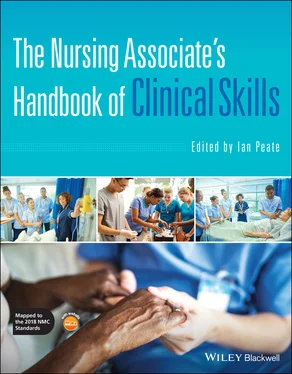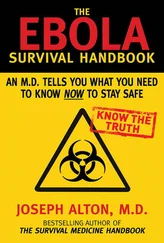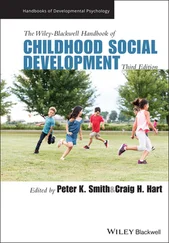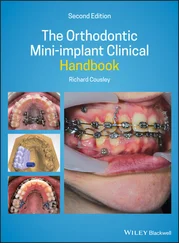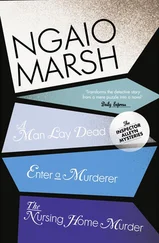The Nursing Associate's Handbook of Clinical Skills
Здесь есть возможность читать онлайн «The Nursing Associate's Handbook of Clinical Skills» — ознакомительный отрывок электронной книги совершенно бесплатно, а после прочтения отрывка купить полную версию. В некоторых случаях можно слушать аудио, скачать через торрент в формате fb2 и присутствует краткое содержание. Жанр: unrecognised, на английском языке. Описание произведения, (предисловие) а так же отзывы посетителей доступны на портале библиотеки ЛибКат.
- Название:The Nursing Associate's Handbook of Clinical Skills
- Автор:
- Жанр:
- Год:неизвестен
- ISBN:нет данных
- Рейтинг книги:4 / 5. Голосов: 1
-
Избранное:Добавить в избранное
- Отзывы:
-
Ваша оценка:
- 80
- 1
- 2
- 3
- 4
- 5
The Nursing Associate's Handbook of Clinical Skills: краткое содержание, описание и аннотация
Предлагаем к чтению аннотацию, описание, краткое содержание или предисловие (зависит от того, что написал сам автор книги «The Nursing Associate's Handbook of Clinical Skills»). Если вы не нашли необходимую информацию о книге — напишите в комментариях, мы постараемся отыскать её.
The Nursing Associate’s Handbook of Clinical Skills
The Nursing Associate’s Handbook of Clinical Skills
The Nursing Associate's Handbook of Clinical Skills — читать онлайн ознакомительный отрывок
Ниже представлен текст книги, разбитый по страницам. Система сохранения места последней прочитанной страницы, позволяет с удобством читать онлайн бесплатно книгу «The Nursing Associate's Handbook of Clinical Skills», без необходимости каждый раз заново искать на чём Вы остановились. Поставьте закладку, и сможете в любой момент перейти на страницу, на которой закончили чтение.
Интервал:
Закладка:
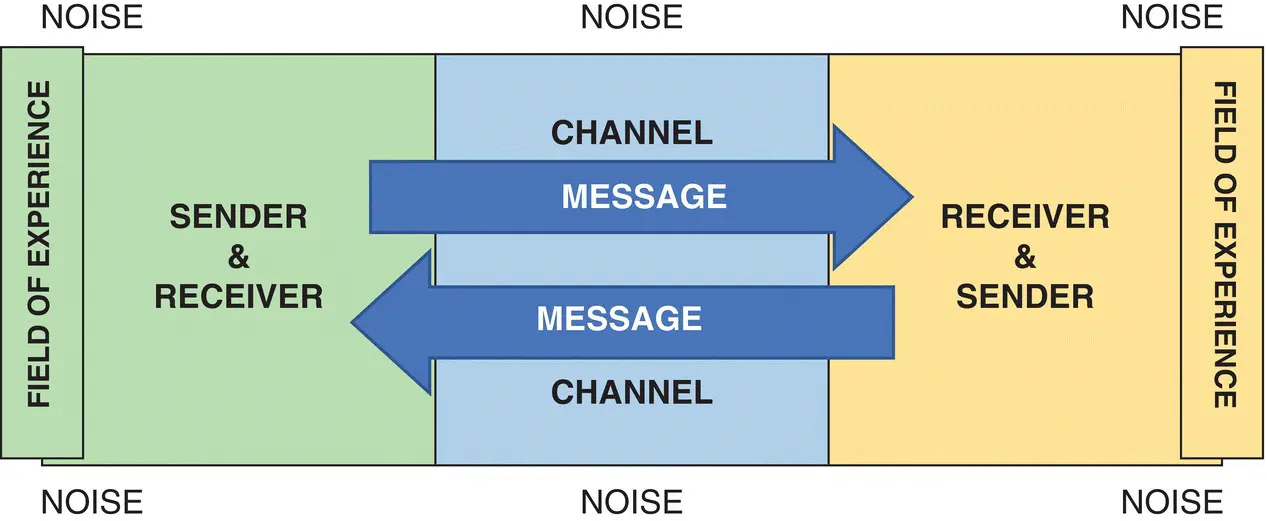
Figure 1.2 Interaction model of communication.
Source: Adapted from Schramm (1997).
The Transactional Model of Communication
As the study of communication progressed, models expanded to account for more of the complex elements of the communication process. The transactional model of communication places emphasis on the concurrent and continuous nature of communication. In this model, all those involved in the communication experience are simultaneously the sender and receiver, continuously sending and receiving information and feedback from each other using verbal and non‐verbal communication (Barnlund 1970).
The transactional model describes communication as a process in which communicators (can be more than two people) generate social realities within social, relational and cultural contexts. The purpose of communication is not simply to exchange messages but to also create relationships, develop intercultural relations, shape self‐concepts and engage with others to create communities.
Blue Flag
 The therapeutic relationship is an essential prerequisite to effective communication between health professionals and patients in order to not only transmit information but also effectively address mental processes that become activated by it. The communication between the nursing associate and the patient includes the ability to express genuine concern for the care of the patient, with the patient becoming a participant.
The therapeutic relationship is an essential prerequisite to effective communication between health professionals and patients in order to not only transmit information but also effectively address mental processes that become activated by it. The communication between the nursing associate and the patient includes the ability to express genuine concern for the care of the patient, with the patient becoming a participant.
The transactional model also considers the context in which the communication occurs, which shapes the way you communicate; consideration is given not only to the content of the message (the what) but also to the relational dynamics (the how it is said). Like the interactional model of communication, the transactional model acknowledges the participants’ field of experience but includes a more complex understanding of communication across physical, psychological, social, cultural and relational contexts. Figure 1.3outlines the transactional model.
The transactional model agrees that physical and psychological contexts are important but in isolation are too simplistic. The transactional model argues that communication is more complex, as it shapes a person’s reality before and after specific interactions occur, and, therefore, emphasis is placed on the importance of contextual influences outside of the single interaction, namely social, cultural and relational contexts.
Social context focuses on the stated rules and unstated norms that guide communication. There are many examples we can draw on from healthcare here. For example, a trainee nursing associate observes that the ward round is monopolised by the consultant and the nurse in charge and the trainee nursing associate may only realise they break this norm from the reaction of others, for example, being told not to talk again during ward round. These types of norms are traditional and have no place in the future of healthcare; the role of the nursing associate is to be resilient and advocate for best patient care.
Green Flag
 The Nursing and Midwifery Council (NMC) (2018) Standards of proficiency for nursing associates
The Nursing and Midwifery Council (NMC) (2018) Standards of proficiency for nursing associates
The NMC standards of proficiency require the nursing associate to understand the importance of courage and transparency and apply the duty of candour, recognising and reporting any situations, behaviours or errors that could result in poor care outcomes (Platform 1: Being an accountable professional; 1.3)
Relational context includes the historical and current relationship you have with an individual. The nursing associate will communicate differently with colleagues compared with family and friends and similarly with people they have just met versus someone they have known for some time. Early interactions are more likely to be governed by the social context of rules and norms but these maybe less apparent as relationships develop. Consider the nursing associates differing response when a patient says ‘Get me a drink’ compared to if a partner were to say it.

Figure 1.3 Transactional model of communication.
Source: Adapted from Barnlund (1970).
Cultural context includes, for example, ethnicity, gender, nationality, sexual orientation, class, ability and ethnicity, and we all have multiple aspects of cultural identity which influence our communication. The nursing associate needs to be aware of unconscious bias, as it harms patients and staff (Kapur 2015). Unconscious (or implicit) bias occurs when the way information is processed is influenced by stereotypes, and, therefore, those stereotypes impact actions and judgements. A stereotype is a belief that associates a group of people with certain traits or characteristics and is a prejudgement of a person based on the group they are associated with. Unconscious bias is a natural method of cognitive processing, so we all possess it. In healthcare, unconscious bias can lead to false assumptions and negative patient outcomes, especially in minority groups. An example might be that the nursing associate inadvertently spends less time with the patient with mental health issues because of the stereotype they hold that all people with mental health issues are violent. It is important for the nursing associate to be aware of unconscious bias and, while it will always exist, develop strategies to overcome it.
Yellow Flag
 Health Education England have developed a Cultural Competence e‐learning package to support health professionals in developing cultural competence https://www.e‐lfh.org.uk/programmes/cultural‐competence/
Health Education England have developed a Cultural Competence e‐learning package to support health professionals in developing cultural competence https://www.e‐lfh.org.uk/programmes/cultural‐competence/
The three models of communication (transmission, interactive and transactional) while relevant to the role of the nursing associate, as they apply to all forms of human interaction, were developed to describe communication in general. The nurse‐patient relationship is, by its very nature, embedded in interpersonal communication. There are a number of communication theories that have been developed in nursing to help explain and guide interactions between nurses and patients (Bylund et al. 2012). One such theory is Peplau’s interpersonal relations theory (1997) which focuses on the nurse‐patient relationship and the therapeutic process that takes place. Although the focus is on the nurse‐patient relationship, it is similar to the transactional model in that communication that occurs in this context involves complex factors such as environment, attitudes and beliefs and culture. Peplau’s interpersonal relations theory defines four stages of the relationship that achieve a common goal:
Orientation phase: This is the initial stage of the relationship where the nursing associate demonstrates patient‐centred care that enables the patient to ask questions and develop trust in the nursing associate. First impressions of the nursing associate and the healthcare provision begin to evolve. This phase sets the stage for a more trusting relationship and is where the nursing associate would introduce themselves (Granger 2014), collect information about the patient’s needs, potential, interests and the patient’s susceptibility to experience fear or anxiety (Fawcett 2010).
Читать дальшеИнтервал:
Закладка:
Похожие книги на «The Nursing Associate's Handbook of Clinical Skills»
Представляем Вашему вниманию похожие книги на «The Nursing Associate's Handbook of Clinical Skills» списком для выбора. Мы отобрали схожую по названию и смыслу литературу в надежде предоставить читателям больше вариантов отыскать новые, интересные, ещё непрочитанные произведения.
Обсуждение, отзывы о книге «The Nursing Associate's Handbook of Clinical Skills» и просто собственные мнения читателей. Оставьте ваши комментарии, напишите, что Вы думаете о произведении, его смысле или главных героях. Укажите что конкретно понравилось, а что нет, и почему Вы так считаете.
